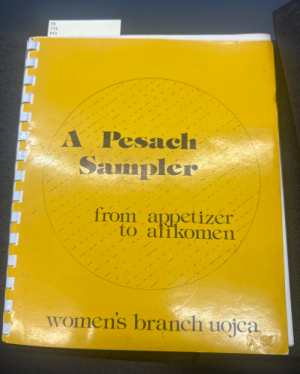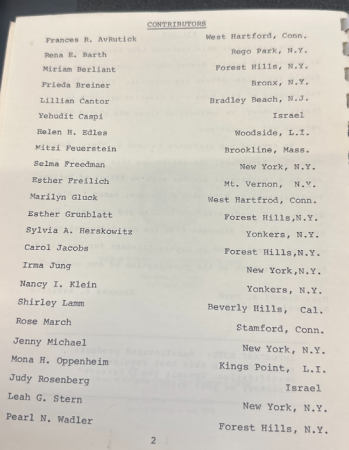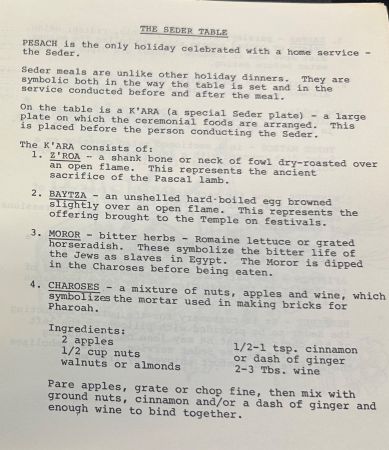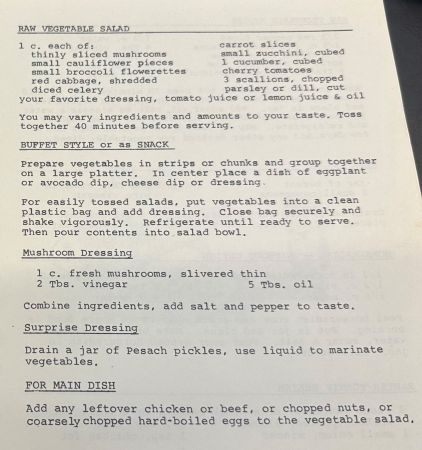A Pesach Sampler: from appetizer to afikomen

A Pesach Sampler: from appetizer to afikomen is a printed cookbook of recipes for the Jewish holiday of Passover. The cookbook was published in the Gregorian year 1979, or the Hebrew year 5739. The book was printed, published, and distributed by the Women’s Branch of the Union of Orthodox Jewish Congregations of America (UOJCA) in New York, New York. The book is currently held in the Kislak Center for Special Collections, Rare Books, and Manuscripts at the University of Pennsylvania, and found its way there by a donation from Martin Kaminer in 2019.
Historical Context
Judaism and Passover
Judaism is the world’s oldest monotheistic religion, which means it is based upon the belief that there is only one God who has established a covenant with them. Jewish practitioners, or Jews, worship in holy places known as synagogues, and their spiritual leaders are called rabbis. The six pointed Star of David is the symbol of Judaism. Today, there are about 14 million Jews worldwide, most of whom live in the United States and Israel. A person is traditionally considered Jewish if his or her mother is Jewish.[1] Many Jewish holidays often include festivities with one’s Jewish family and cooking meals for everyone to enjoy. Of the many Jewish holidays that fall throughout the year, A Pesach Sampler lists recipes specific to the Jewish holiday of Passover, or Pesach in Hebrew. The holiday is typically celebrated sometime in the Gregorian month of April, as the starting date is determined by the Hebrew calendar, on the 15th day of the month of Nisan. Jews gather with family and friends in the evening to read from a book called the Haggadah, which tells the story of Passover and contains through a combination of prayers, rituals, readings, and songs during the dinner meal, collectively referred to as the ritual of the Seder.[2] During the holiday of Passover and during the Seder, Jews are prohibited from eating leavened and fermented grain products due to what the holiday celebrates: the Jewish escape from Egyptian slavery. When the Jews escaped Egypt, they did not have time to let their bread rise before heading into the desert, and as such, their bread baked flat, instead of rising.[3] As such, all food that comply with this dietary restriction and are allowed to be consumed during Passover are said to be Kosher for Passover.
UOJCA
The Union of Orthodox Jewish Congregations of America (UOJCA) is the largest organization of Orthodox synagogues in the U.S. The UOJCA was founded in 1898 and was oriented toward the few English-speaking, rather than the Yiddish (Hebrew) speaking congregations of Jews. The organization is best known for its committee for the multinational operation that certifies over 400,000 industrial and consumer products manufactured in 73 countries under the kashrut laws, which are the Jewish laws that specify what foods are Kosher and what foods are not.[4][5][6] The process began in 1923 when the Women’s Branch of the UOJCA formed the Kashruth (Kashrut) Committee. The committee worked to persuade manufacturers to replace non-kosher ingredients with kosher, and became a non-profit in 1925. Heinz ketchup was the first product to sport the UOJCA certified kosher label.[7]
Community Cookbooks
The New York Public Library also holds a copy of A Pesach Sampler, and categorizes it under the genre “Community Cookbooks”.[8] The community cookbook can be dated back to just after the Civil War in the United States, when northern women developed money-raising strategies to support the Sanitary Commission of the Union Army. Among other items, such as quilts and food items, communally authored cookbooks paid for bandages, medicines, doctors, and nurses in the war. After the Civil War, other organizations like churches and synagogues adopted the use of fund-raising cookbooks. Until very recently, all such recipe collections have been produced by women.[9] Early post-war Jewish community cookbooks allowed the women who authored them to “shape the communities around them.”[10] The mission of fundraising propelled postwar community cookbooks as well.[11]
Material Analysis
The Physical Book

A Pesach Sampler appears to be hand bound with a comb binding. Due to the cookbooks probable use as a fundraising device and a community cookbook, it appears to be contemporary when taking into account the decade in which this cookbook was published. The substrate of the book is cheap flimsy paper, and the cover and binding appear to be made out of a cheap, glossy cardstock. In the realm of self-publishing, cookbooks typically feature comb binding, and the glossy cover allows it to be easily washed of food remnants.[12] The book is formatted in a codex that has the first page at the front of the book. The cookbook has 76 pages made up of 38 bound sheets and a front abd back cover. Each page is approximately 6 by 8 inches. The text within the book reads left to right and is entirely written in English. The book does not contain any physical evidence of readership, as it is in relatively good condition and does not appear to have circulated and changed many hands since its printing and release in 1976.
Textual Analysis
Content
The book opens to a first page with the title, A Pesach Sampler, and the publisher, the UOJCA, on the bottom. The second page details the copyright date, 1976, the full name and address of the publisher, the UOJCA, and the Library of Congress Catalog Card Number, as well as the individual dates of both printings of the cookbook, March and July 1976. The third page dedicates the book to Mrs. Ferdinand S. Oppenheim, a founder of Women’s Branch, and details the Hebrew and Jewish date of publishing. Upon further research, not much information is available on Mrs. Oppenheim. The cookbook begins with a table of contents, which divides the non-recipe section further into separate sections, the “Preface,” the “Contributors”, the “Recipe Index”, the “Hints to Make Pesach Cleaning Easier,” and the “Seder Table,” and then sorts each recipe by type of food (i.e., Appetizers, Meat, Dessert) and lists each recipe’s page number. The Preface of the book shares that “the recipes in this cookbook have been submitted by members of Women’s Branch UOJCA. Some recipes are family favorites, others are original. They reflect the purpose of this book – a creative approach to Pesach cookery.” As such, the contributors are listed on the following page. The Recipe Index is essentially the part of the table of contents that gives each recipe’s page number and sorts them by type of food. The Hints to Make Pesach Cleaning Easier lists forty four different tips to, as the title of the section states, make cleaning easier. Examples include “shop early” and “clean and defrost freezer early.” The Seder Table section guides the reader on how to properly set up every aspect of the Seder table, including all of the food and drink items that will be necessary for the Seder as stated in the Haggadah. The main section consists of detailed recipes for each item with precise measurements (i.e. cups and ounces for liquids, minutes for time). Many of the food items included in the cookbook are traditional Jewish and Passover foods, which is not a surprise since they are a collection of recipes of many contributors from the UOJCA. The cookbook ends abruptly with a dessert recipe for “Quickie Eggplant.” The cookbook does not contain any written evidence of readership, such as marginalia or annotations, aside from a handwritten library catalog number on the final page that matches the one found on the Franklin Library at The University of Pennsylvania catalog.
-
Table of Contents
-
Cleaning Instructions
-
Contributors
-
Seder Table Instructions
-
Example Recipe
Significance
A Pesach Sampler gives us some insight into what a community cookbook is, and opens the door for the exploration of how women have shaped the genre. However, it also says a lot about the mission of its self-publisher, the Women’s Branch of the UOJCA. The UOJCA has always worked to integrate Orthodox traditions both seamlessly and in pace with changing American lifestyles[13], as evident with their famous efforts to make kosher food ingredients easy to spot. So, it should come to no surprise that a community cookbook from within the organization would help promote the usage of such ingredients for passover cooking. As a non-profit, the community cookbook may help fundraise for the UOJCA, as it appears that they release editions of the cookbook each year. However, we may recognize a deeper mission based on a closer analysis. The book is cheaply made, and probably did not cost much. The entire book is written in plain English instead of Hebrew, and reads left to right, front to back, instead of the opposite which is typical for Hebrew. The book details instructions for properly cleaning and setting up for Passover (which are things that very Orthodox Jews probably already know), but includes very traditional Jewish Passover delicacies. When taking this into account, the deeper mission may have been to spread traditional practices and foods of Passover to less Orthodox and less traditional Jewish-American families who have not been exposed to such things.
References
- ↑ History.com Editors. “Judaism: Founder, Beliefs & Facts.” History.com, A&E Television Networks, https://www.history.com/topics/religion/judaism.
- ↑ ReformJudaism.org Editors. “Passover: History.” Reform Judaism, https://reformjudaism.org/jewish-holidays/passover/passover-history.
- ↑ Avey, Tori. “What Foods Are Kosher for Passover?” Tori Avey, 16 Mar. 2021, https://toriavey.com/what-foods-are-kosher-for-passover/#:~:text=Leavened%20and%20fermented%20grain%20products,product%20is%20prohibited%20during%20Passover.
- ↑ Jeffrey S. Gurock American Jewish Orthodoxy in Historical Perspective (1996); C.S. Liebman, in: AJYB, 66 (1965), 21–97; E. Markovitz, in: AJHSQ, 55 (1966), 364–84.
- ↑ Union of Orthodox Jewish Congregations of America, https://www.jewishvirtuallibrary.org/union-of-orthodox-jewish-congregations-of-america.
- ↑ “Kashrut: Jewish Dietary Laws.” Kashrut: Jewish Dietary Laws - Judaism 101 (JewFAQ), https://www.jewfaq.org/kosher_dietary_laws.
- ↑ “Union of Orthodox Jewish Congregations of America Records.” Collection: Union of Orthodox Jewish Congregations of America Records | The Center for Jewish History ArchivesSpace, https://archives.cjh.org/repositories/3/resources/18390/collection_organization.
- ↑ “Research Catalog.” NYPL, https://www.nypl.org/research/research-catalog/bib/b16553183.
- ↑ Bower, Anne L. "Our Sisters' Recipes: Exploring "community" in a community cookbook." Journal of Popular Culture, vol. 31, no. 3, 1997, pp. 137-151. ProQuest, https://proxy.library.upenn.edu/login?url=https://www.proquest.com/scholarly-journals/our-sisters-recipes-exploring-community/docview/195362557/se-2.
- ↑ Anne L. Bower, “Introduction,” in Recipes for Reading, pp. 2, 6.
- ↑ Lara, Rabinovitch. “A Peek into Their Kitchens: Postwar Jewish Community Cookbooks in the United States.” Pp. 91-116. Taylor & Francis, https://www.tandfonline.com/doi/abs/10.2752/175174411X12810842291263.
- ↑ Salisbury, Jim, and Linda Grotke Salisbury. “Smart Self-Publishing: An Author's Guide to Producing a Marketable Book.” Google Books, Tabby House, 2003, https://www.google.com/books/edition/Smart_Self_publishing/Yd9NRpaSQAYC?hl=en&gbpv=0.
- ↑ “Union of Orthodox Jewish Congregations of America Records.” Collection: Union of Orthodox Jewish Congregations of America Records | The Center for Jewish History ArchivesSpace, https://archives.cjh.org/repositories/3/resources/18390/collection_organization.




